All Library locations will be closing early Wednesday, November 26 at 5 p.m. and will reopen Saturday, November 29.
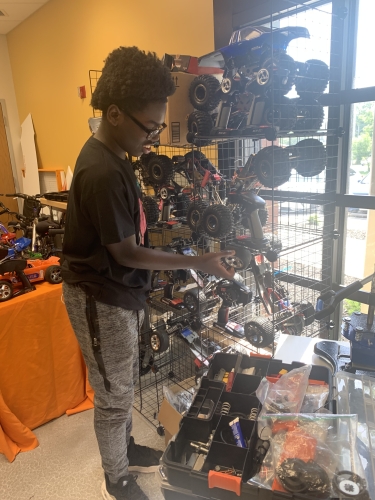
Standing by a rack of remote-controlled cars he’s worked on all summer, 12-year-old Maceo says that after changing their tires and repairing and painting them all summer, he may be interested in becoming a mechanic.
“It’s a maybe. I might do it when I’m retired from football,” Maceo says.
Students who frequent the Kansas City Digital Media Lab (KCDML) at the Southeast Branch spend quite a bit of time considering future goals. The lab, which opened in its current form in 2018, houses equipment, technology, and support that they may not find elsewhere.
Each summer since 2015, students 12 to 18 years old, engage in many types of projects during the KCDML camp, and working on R/C cars is only one example. The seven-week program at the Southeast Branch selects about 12 students from 20 or so applicants.
While the 13 cars in the lab don’t require oil changes or spark plug gapping, working on them helps students explore careers or hobbies they might want to pursue.
Lead Facilitator Marcus Brown says he chose “hobby level cars that have full parts lists, just like if you were going to AutoZone, versus like a car you would get from Walmart that once it's broken, it’s broken.”
In addition to painting the cars and changing their tires, they design and print 3-D add-ons, such as spikes and a Pokémon figure, which they’ve positioned as a driver within a Star Wars-style gun turret that they also printed.
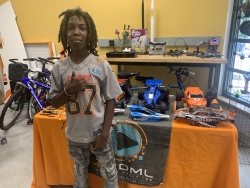
Jordan, 12, says that in addition to painting and changing tires, he also made a wheelie bar. “My favorite part was researching how to connect it onto the car.”
A GoPro mounted on the car the students call “Max” combined with drone footage they recorded, allowed them to create cinematic takes on their drives and crashes.
But not every student worked on cars.
This summer, high school seniors wanted to prepare for the future.
“We used the camp as a way for them to get their resumes together, fill out some job applications, and be able to be a little bit more thoughtful in how they speak,” Brown explains. “One kid was working on getting his driver's license, so he took the practice test and did the driver simulator."
A few years ago, students turned the lab into a record label and wrote three songs, including “Family.” Together, they composed, performed, recorded, and edited their work. They even designed an album cover.
The camp is all about making sure the students are as successful as possible in whatever they do, Brown says.
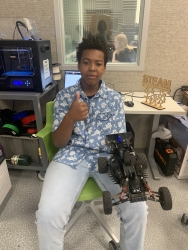
But, he explains, “it is a lab too, so we have that expectation that some people are not going to finish [their projects].”
For example, students who arrive hoping to get into animation or video game design often leave with a reality check — even a 10-second animation takes a lot of practice and a very long time to create.
“You learn how to curb expectations, and you get a dose of reality of where your skills meet what you can bring to the table. So again, it's a place for people to take chances in a low-stakes environment,” Brown says.
For younger students, the KCDML offers slightly different programming, serving as an introduction to what the lab has to offer.
The tween camp takes place in June each year and lasts all day, four days a week. Digital Media Lab Youth Services Librarian Kiesha Collins leads the 8- to 11-year-olds.
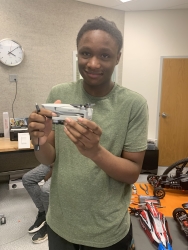
“It’s a way to get younger kids in the space; originally the Digital Media Lab was for teens,” she says.
Over the past three years, Collins’ camp has grown steadily and now serves 15 students. The group works on STEAM (science, technology, engineering, and mathematics) projects in the lab and partners with the Missouri Department of Conservation for outdoor activities.
Marcus says the already-growing KCDML program has further plans for expansion. In June, the Carnegie Corporation awarded the Library $500,000 as part of a national effort called Libraries as Pillars of Education and Democracy. A portion of this funding will support the KCDML.
Brown says the new funding will allow them to add a tutorial program to help students with college and career readiness and will extend to assist 18- to 24-year-olds.
“A lot of our young people are graduating, but they still need resources. Already, after you graduate, you can still come and take advantage of the space for an entire year, but now we'll be able to be pointed with scheduled and programmatic activities for them to engage in,” Brown says.
The grant will also help the Library continue to hire summer camp alumni as summer assistants, which they have already done for a few years. The lab has four full-time staff members who support students in whatever ways they need.
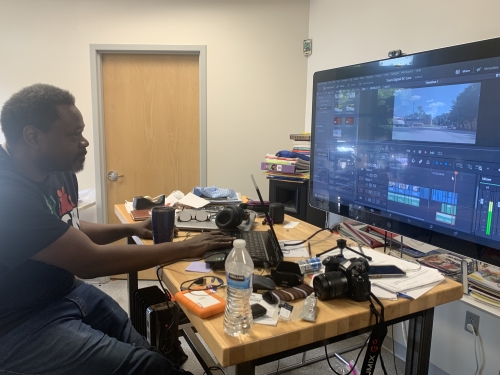
Brown and KCDML Facilitator Arlis Gammill offer one-on-one tutoring, but sometimes several students come in at the same time. “We have people that have been hired to do one thing, but they're all hands-on deck for whatever the mission is going to be,” Brown says.
Ten years into lab programming, the team has seen a lot of its students succeed. In the 2024-25 school year, they supported seven students in a variety of ways, including social and emotional, and those students invited the entire KCDML staff to their graduation.
In fact, they’ve seen enough successes that such invitations are part of a metric Brown came up with.
“I base my success on graduations and weddings I'm invited to,” he says.
He and his colleagues have been to several of each. The group of students who issued the invitation in May included the valedictorian of Southeast High School who started at the University of Kansas this fall on a full-ride scholarship.
Another recent graduate landed a job in graphic design with the school district thanks to the skills he developed in the lab.
Brown says, “I think those types of things are what really lets us know that we're hitting the nail on the head.”